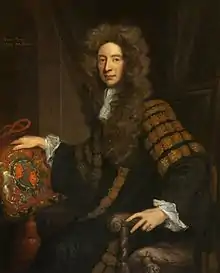Patrick Hume, 1st Earl of Marchmont
Patrick Hume, 1st Earl of Marchmont (13 January 1641 – 2 August 1724), known as Sir Patrick Hume, 2nd Baronet from 1648 to 1690 and as Lord Polwarth from 1690 to 1697, was a Scottish statesman. His grandfather was the poet and courtier Sir Patrick Hume of Polwarth and Redbraes who died in 1609.
The Earl of Marchmont | |
|---|---|
 Portrait by Godfrey Kneller. | |
| Lord Chancellor of Scotland | |
| In office 1696–1702 | |
| Monarch | William II |
| Preceded by | The Marquess of Tweeddale |
| Succeeded by | The Earl of Seafield |
| Personal details | |
| Born | 13 January 1641 Polwarth, Berwickshire, Scotland |
| Died | 2 August 1724 (aged 83) Berwick-on-Tweed, Great Britain |
| Resting place | Canongate Kirkyard, Edinburgh |
| Spouse(s) | Grizel Ker |
| Children | 4 sons 5 daughters |
| Alma mater | University of Paris |
| Military service | |
| Battles/wars | Argyll's Rising Glorious Revolution |
Life
Born at Polwarth, Berwickshire, he was raised as a strict Presbyterian, and after a term of law study at Paris he became a member of the Scottish parliament in 1665 as shire commissioner for Berwickshire, where he at once took a foremost place as defender of the Covenanters. He went so far as to bring imprisonment upon himself, and on being freed was suspected of complication in the Rye House Plot, so that he was forced to remain in hiding until he could escape in disguise to the Netherlands.[1] There he joined Archibald Campbell, 9th Earl of Argyll and embarked with him on the unsuccessful 1685 expedition to Scotland. Hume became a refugee with a price set upon his head; but he once more escaped abroad and lived at Utrecht under the name "Dr. Wallace," professing to be a Scottish surgeon. He returned with William of Orange at the Revolution of 1688, and once again joined the Scottish parliament as the commissioner for Berwickshire until becoming Lord Polwarth in 1690.
With his estates restored and now a Scottish peer, he was made Lord Chancellor in 1696 and Earl of Marchmont in 1697, although when Anne came to the throne in 1702 he lost his chancellorship.[1] He strenuously opposed in Parliament the claims of the Old Pretender to the crown and voted for the union of Scotland with England, though he was not above the suspicion of having received a reward for so doing. Too dogmatic to be popular, he did not hold office in Great Britain until the reign of George I, when he was given some minor charges, but shortly afterwards retired. Hume was an active freemason, he belonged to St Mary's Lodge, Ediburgh since 1667.[2]
Family
At least six of his children died in infancy and were buried in the Foulis tomb in Greyfriars Kirkyard.[3] His son, Sir Andrew Hume, later Lord Kimmerghame, served as a commissioner in parliament for Kirkcudbright. [4]
He was great-nephew to both Patrick Hume of Polwarth and Rev Alexander Hume.[5]
His daughter, Grisell Hume (later Lady Grisell Baillie) wrote the popular 17th song "Werna my Heart Licht I Wad Dee" (Were not My Heart Light I would Die).
References
- Chisholm, Hugh, ed. (1911). . Encyclopædia Britannica. 17 (11th ed.). Cambridge University Press. p. 691.
- Steve Murdoch (2010). "Conspiratorial Networks in the North? A Review of Jacobite and Hanoverian Freemasons in Scandinavia and Russia, 1688-1746". Politica Hermetica, 24 Sorbonne. Retrieved 1 December 2019.
- Register of interments in the Greyfriars burying-ground, Edinburgh, 1658-1700
- David Wilkinson, HUME, Hon. Sir Andrew (1676-1730), of Kimmerghame, Berwick. in The History of Parliament: the House of Commons 1690-1715 (2002).
- Logie: A Parish History Menzies Fergusson 1905
- This article incorporates text from a publication now in the public domain: Gilman, D. C.; Peck, H. T.; Colby, F. M., eds. (1905). New International Encyclopedia (1st ed.). New York: Dodd, Mead. Missing or empty
|title=(help) - Leigh Rayment's Peerage Pages
- Lee, Sidney, ed. (1891). . Dictionary of National Biography. 28. London: Smith, Elder & Co.
| Political offices | ||
|---|---|---|
| Preceded by The Marquess of Tweeddale |
Lord Chancellor of Scotland 1696–1702 |
Succeeded by The Earl of Seafield |
| Peerage of Scotland | ||
| New creation | Earl of Marchmont 1697–1724 |
Succeeded by Alexander Hume-Campbell |
| Lord Polwarth 1690–1724 | ||
| Baronetage of Nova Scotia | ||
| Preceded by Patrick Hume |
Baronet (of Polwarth) 1648–1724 |
Succeeded by Alexander Hume-Campbell |
| Military offices | ||
| Preceded by Marquess of Lothian |
Colonel of the 7th Regiment of Dragoons 1707–1709 |
Succeeded by William Kerr |